Discover the delightful world of Pètanque, a beloved French ball sport that offers a unique and entertaining experience for families, couples, and everyone in between.
While you may not be familiar with Pètanque, it is a game that brings people together, fostering friendly competition and creating lasting memories.
This article will explore the rules, techniques, and benefits of Pètanque, providing valuable insights and tips to enhance your experience.
So, whether you’re a beginner or an experienced player, get ready to embark on a journey of skill, strategy, and fun with Pètanque – a game that transcends language and unites people in a shared passion.
Good To Know
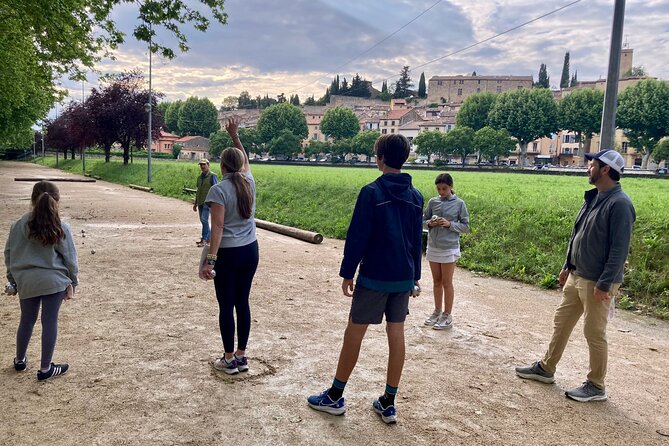
- Pètanque is a popular French outdoor game played with metal balls called boules.
- The objective is to throw the boules as close as possible to a smaller wooden target ball called the cochonnet.
- Pètanque offers endless fun and excitement for players of all skill levels.
- Pètanque promotes physical fitness, hand-eye coordination, balance, stability, and strategic thinking.
What Is Pètanque?
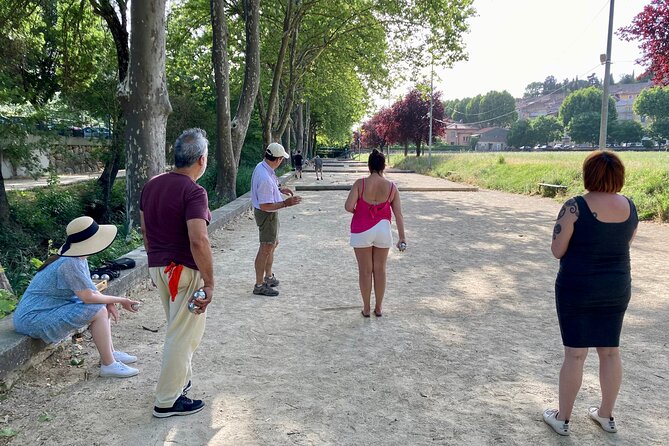
Pètanque, a popular French outdoor game, is a delightful pastime enjoyed by people of all ages and skill levels. Originating in Provence, this game is played with metal balls, called boules, on a flat surface covered in gravel or sand.
The objective of pètanque is to throw your boules as close as possible to a smaller wooden target ball, called the cochonnet. To excel at pètanque, players must master various techniques, such as the pointing technique, which involves aiming to get the boule as close to the cochonnet as possible, and the shooting technique, which involves knocking opponents’ boules away from the target.
Pètanque strategies also come into play, with players strategically placing their boules to block opponents and secure their own points. Whether you’re a beginner or a seasoned player, pètanque offers endless fun and excitement.
Find more activities and experiences we've covered in Provence.
History of Pètanque
Originating in the picturesque region of Provence, the history of Pètanque is a fascinating journey that takes us back to the origins of this beloved French outdoor game.
Pètanque, also known as boules, traces its roots to ancient Greece and Rome, where similar ball throwing games were played.
However, it wasn’t until the early 20th century that Pètanque gained popularity in France. The game was introduced to the public by Jules Le Noir, who organized the first Pètanque tournament in 1907.
Since then, Pètanque has become a cherished pastime enjoyed by people of all ages and backgrounds. Over the years, many famous Pètanque players have emerged, including Philippe Quintais, Bruno Le Boursicaud, and Dylan Rocher, who’ve achieved great success in national and international competitions.
How to Play Pètanque
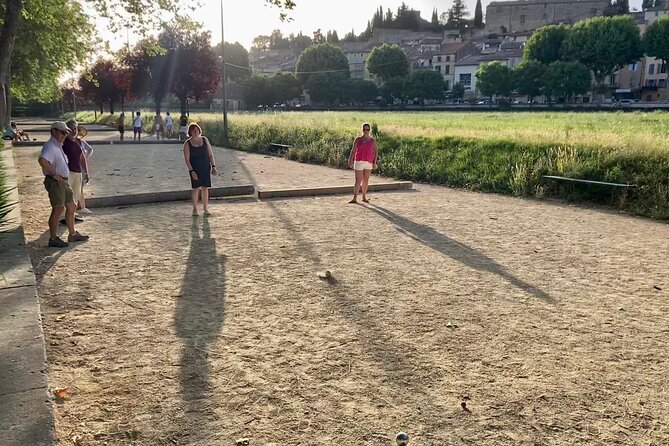
To play Pètanque, players take turns throwing metal balls towards a smaller wooden target ball called the cochonnet. Here are some techniques and strategies to help you enjoy the game:
Choosing the right ball: Pètanque balls come in different sizes and weights. Select a ball that feels comfortable in your hand and suits your throwing style.
Grip and stance: Hold the ball with a firm but relaxed grip. Stand with your feet shoulder-width apart and align your body towards the cochonnet.
Aim and throw: Visualize the path you want the ball to take and aim for a spot near the cochonnet. Use a smooth throwing motion, releasing the ball at the right moment to achieve accuracy.
Strategy: Consider the position of other balls on the field and plan your shots accordingly. Aim to get your ball closer to the cochonnet than your opponents’ balls or knock their balls away to gain an advantage.
Pètanque Equipment and Rules
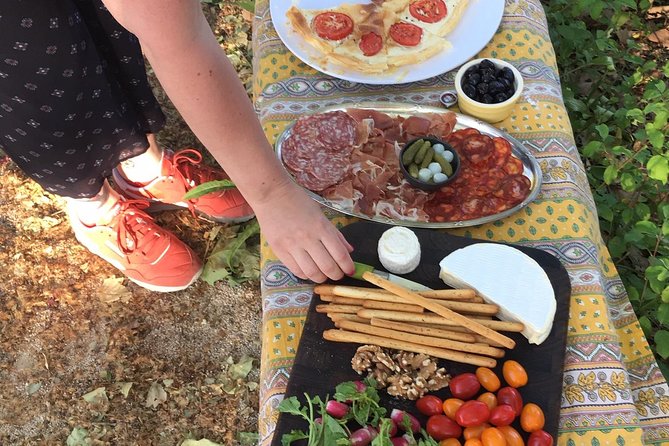
The equipment used in Pètanque consists of metal balls and a wooden target ball, along with a set of rules that govern the gameplay. Pètanque equipment suppliers offer a variety of options for players to choose from, including different sizes and weights of metal balls. The wooden target ball, also known as the cochonnet, is usually smaller and lighter than the metal balls.
To further understand the equipment and rules of Pètanque, refer to the table below:
| Equipment | Description |
|---|---|
| Metal Balls | Made of steel or iron, available in different sizes and weights |
| Wooden Target Ball (Cochonnet) | Smaller and lighter than the metal balls, typically made of wood |
Pètanque strategy tips can help players improve their gameplay. Some key tips include:
- Choose the right ball size and weight based on personal preference and playing style.
- Aim to get your metal ball as close as possible to the cochonnet.
- Observe the position of other players’ balls and plan your shots accordingly.
Health Benefits of Playing Pètanque

Continuing our exploration of Pètanque, let’s now uncover the remarkable health benefits that come with playing this popular French game.
Physical Fitness: Pètanque requires players to stand, walk, and bend while throwing the boules (metal balls). This promotes cardiovascular health, boosts endurance, and improves overall fitness.
Hand-Eye Coordination: Precise aiming and throwing techniques in Pètanque enhance hand-eye coordination. This skill is crucial for various daily activities and sports.
Balance and Stability: Pètanque involves maintaining balance while throwing the boules on uneven terrain. This helps to improve balance and stability, reducing the risk of falls and injuries.
Mental Stimulation: Pètanque requires strategic thinking and planning. Players must analyze the terrain, opponents’ moves, and plan their shots accordingly. This mental exercise enhances cognitive skills and keeps the brain sharp.
Pètanque for Families and Couples

Families and couples can enjoy the delightful game of Pètanque, creating fun-filled memories together while engaging in friendly competition. Pètanque, a traditional French sport, is perfect for families and couples looking to bond and have a great time. To help you make the most of your Pètanque experience, here are some key pètanque etiquette and strategies to keep in mind:
| Pètanque Etiquette | Pètanque Strategies |
|---|---|
| – Take turns and wait for your opponents to finish their throws before starting yours. | – Aim to get your boule (metal ball) as close as possible to the cochonnet (small wooden ball). |
| – Be respectful and avoid distracting or disturbing other players. | – Analyze the terrain and adjust your throwing technique accordingly. |
| – Learn the proper way to measure distances and settle any disputes. | – Consider the weight and size of your boule to optimize your throws. |
| – Celebrate both your successes and your opponents’ achievements. | – Strategize with your partner to outmaneuver your opponents. |
With these tips in mind, families and couples can have a fantastic time playing Pètanque, strengthening their relationships while enjoying a friendly game.
Pètanque Tournaments and Events
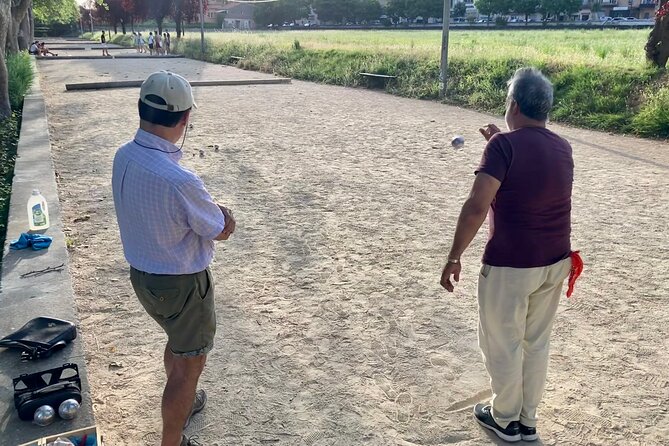
Pètanque enthusiasts can take their love for the game to the next level by participating in exciting tournaments and events that showcase the competitive spirit and camaraderie of this traditional French sport. Here are four reasons why pètanque tournaments and events are a must for any pètanque lover:
Compete against skilled players: Pètanque tournaments bring together players of all skill levels, giving participants the opportunity to challenge themselves against some of the best in the sport.
Experience the thrill of competition: From the intense matches to the nail-biting moments, pètanque tournaments offer an adrenaline-filled experience that will keep players on the edge of their seats.
Make new friends: Pètanque events aren’t just about the competition. They also provide a chance to meet fellow enthusiasts, share tips and strategies, and forge lasting friendships.
Enjoy the pètanque culture: By participating in tournaments and events, players can fully enjoy the rich history and traditions of pètanque, gaining a deeper appreciation for the sport.
Where to Play Pètanque in English
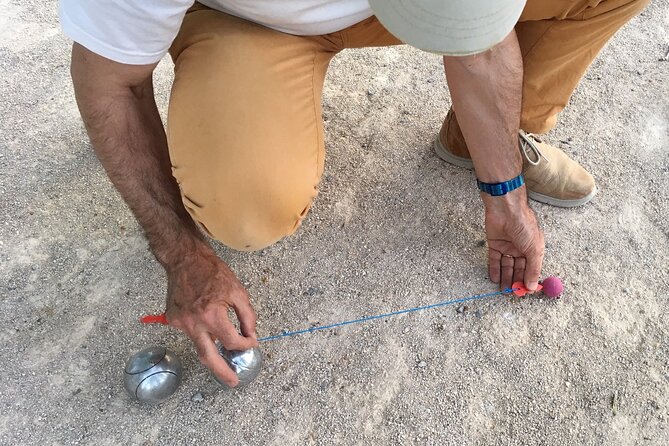
For English-speaking visitors eager to enjoy a game of pètanque, there are several venues available that cater to their language needs. Whether you’re a beginner or an experienced player, these locations offer a fun and welcoming atmosphere where you can rent pètanque equipment and join pètanque clubs and leagues. Here are some options to consider:
| Venue | Location | Services Provided |
|---|---|---|
| Le Club Pètanque | Paris | Equipment rental, pètanque lessons, leagues |
| The Pètanque Place | London | Equipment rental, pètanque tournaments, social events |
| Pètanque Central | New York City | Equipment rental, pètanque clubs, private lessons |
| La Boule D’Or | Sydney | Equipment rental, pètanque leagues, social gatherings |
| Pètanque Paradise | Los Angeles | Equipment rental, pètanque tournaments, coaching |
These venues offer a range of services to ensure that English-speaking visitors have a fantastic pètanque experience. So grab your friends or family, rent some equipment, and join in the fun at these pètanque hotspots.
Common Questions
How Long Does a Typical Game of Pétanque Last?
A typical game of pétanque lasts around 30 minutes to an hour. Players engage in strategic gameplay, aiming to throw their metal balls as close as possible to the target ball called the cochonnet.
Can Children Participate in a Game of Pétanque?
Children can absolutely participate in a game of pétanque. It’s a fun activity for the whole family, allowing kids to develop their throwing skills while enjoying quality time outdoors.
Are There Any Pétanque Leagues or Clubs in the Area?
Yes, there are pétanque leagues and clubs in the area. They provide opportunities for enthusiasts to join organized games, competitions, and social events. It’s a great way to connect with fellow players and enhance your pétanque skills.
Is It Necessary to Bring Your Own Pétanque Balls or Are They Provided?
No, it is not necessary to bring your own pétanque balls as they are provided. When playing pétanque, it is important to choose the right balls for your game based on weight, size, and material.
Can You Play Pétanque on a Beach or Other Non-Standard Playing Surface?
Yes, beach pétanque is possible as an alternative to traditional surfaces. Players can enjoy a game of pétanque on sandy beaches, adding a unique twist to the experience while still enjoying the fun and competitive nature of the game.
The Sum Up
To sum it up, Pètanque is a fantastic game that brings people together and guarantees a fun-filled time for families, couples, and individuals of all ages.
With its rich history, simple rules, and numerous health benefits, Pètanque is an activity worth exploring.
Whether you’re a beginner or an experienced player, the joy and excitement of this beloved French ball sport are sure to create lasting memories.
So grab your boules, gather your loved ones, and enjoy the thrilling world of Pètanque in English.
More Tour Reviews in Provence
- Immersion in the Life of a Hive and its Sacred Bees
- Morning Nature Kayaking on the Durance and Thrilling Afternoon
- Castellane Sunset Apéro
- Commanderie de Peyrassol: Guided tour of the wine cellars
- Commanderie de Peyrassol: Guided tour of the Art Collection
- Commanderie de Peyrassol: Guided tour of the sculpture park by golf cart
Looking for something different? Other Provence activities we've written about
- Immersion in the Life of a Hive and its Sacred Bees
- Morning Nature Kayaking on the Durance and Thrilling Afternoon
- Castellane Sunset Apéro
- Commanderie de Peyrassol: Guided tour of the wine cellars
- Commanderie de Peyrassol: Guided tour of the Art Collection
- Commanderie de Peyrassol: Guided tour of the sculpture park by golf cart
- Cotignac: Wood Sculpture Studio
- Create your own leather bag in Luberon area!
- Create your own leather waist bag in Luberon area!
- French Riviera: Private tour in a vintage convertible car
- Friuli Islands sunset cruise for 9 people
- Luberon: Vineyard Tour and Wine Tasting
